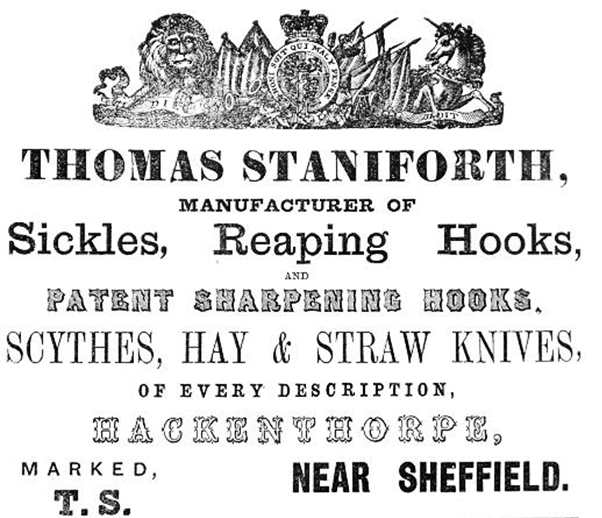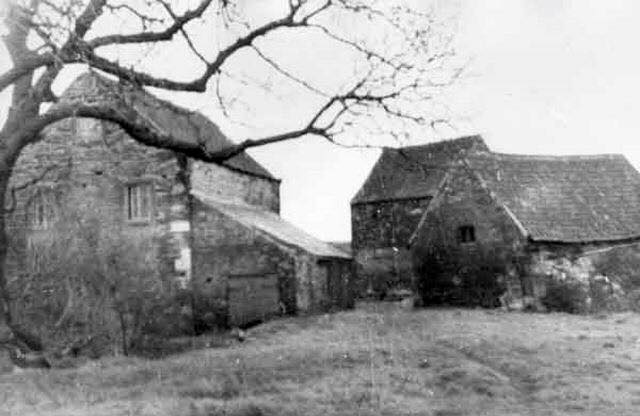
Thomas Staniforth & Co. Sickle works at Hackenthorpe.
 Bedgreave Farm and Corn Mill in 1950
Bedgreave Farm and Corn Mill in 1950
John Staniforth, baptised at Eckington on August 26th, 1768, was the son of Jeremiah Staniforth and Olive Taylor, and the grandson of George Staniforth of Litfield. John was a notable Miller in the village of Beighton, and was it is noted that he was well liked.
On August 26th 1802, he married Mary Morton at Aston, a parish not far from Beighton. On the marriage record John is described as being a Miller from Beighton.
John’s father, Jeremiah passed away in 1772, but when his mother Olive died in 1816 he was left a large quantity of land that had originally belonged to his grandfather, George. This included land at Barlborough and Litfield, and over the years he acquired land in Hackenthorpe, Mosborough and Eckington.
In 1831, a farm as well as farmland at Beighton was surveyed, as John was giving up his tenancy. It comprised of nearly 135 acres as well as a number of buildings, one with a recently enlarged kitchen. In addition he was also operating two corn mills, Beighton Mill and Bedgreave Mill, which still stands near Rother Valley.
That same year however, we find an interesting report:
One Sunday in the middle of April 1831, or to be more strictly accurate, one Monday because it was shortly after midnight, men were walking through the fields between Beighton and Killamarsh near the River rother when they were horrified to see that Belgreave Mill was on fire. It was a dark night there was no moon, but by the light of the flames they could see that it had been broken into, and that papers were strewn about the floor of the counting house, which had the ‘appearance of having been thoroughly rummaged’ By this time the strength of the fire was such that nothing could be done to save the building. By ten O’clock in the morning it had been reduced to a blackened and smoking shell. John Staniforth had become the victim of ‘vile incendiaries’ whose footsteps could be traced in flour all the way through the meadows as far as Killamarsh. Yet despite the efforts of ‘the constables of Sheffield and others’ and although strong suspicion fell on several individuals, no-one was caught and brought to justice.
The next week it was learnt that the attack had been preceded by a threatening letter, signed only ‘Swing’. Outbreaks of Arson had become depressingly frequent during the previous autumn and winter, though they were largely confined to the south of England, where people went in fear of the notorious ‘Captain Swing’ and his followers. Anyone who received a threatening letter which bore this nom-de-guerre could be sure that very soon he would find his ricks burnt, his machinery smashed or his barns ablaze.
According to the newspaper report, John Staniforth was well-liked and had no apparent enemies. However, millers, were traditionally regarded with hostility and distrust. When French stones, reputedly the best mill-stones, were introduced in Woodhouse in the previous century people suspected that these stones were white they would be ground up and mixed with the flour so they forcibly removed them and rolled them down into the Shire Brook. Particularly in the times of dearth and high prices it was believed that millers would exploit their position of monopoly and doubtless there were those among them who were unscrupulous enough to do this.
On this occasion John was doubly unlucky not only was this one of only two or three cases of incendiarism recorded in Derbyshire, but he had decided not long before that his corn stacks were at greater risk than his mill and he had therefore transferred his insurance from the mill to the stacks and consequently now found himself the poorer by some 2,000pound. Nevertheless the mill was rebuilt and was working until about 1947.
This could likely explain why John was ending the tenancy on his land. His wife Mary was buried on December 13th, 1837 at Mosborough, and lived to the age of 77, he was buried on December 20th 1845.
In total, John and Mary had two sons and two daughters: